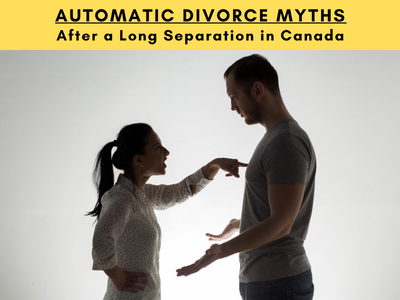Divorce is a significant life event that requires legal proceedings to dissolve a marriage. In Canada, there is often a misconception surrounding the concept of automatic divorce after a long separation. In this blog post, we will clarify the reality behind divorce proceedings in Canada and explain the process involved when couples have been separated for an extended period.

- The Importance of Legal Process: Contrary to popular belief, there is no automatic divorce in Canada, even after a long separation. The legal process plays a crucial role in officially ending a marriage and ensuring the rights and responsibilities of both parties are addressed.
- The Divorce Act and Separation Period: The Divorce Act is the federal legislation that governs divorce proceedings in Canada. According to the Act, a divorce can be granted on the grounds of separation if the spouses have lived separate and apart for at least one year with the intention to end their marriage. This separation period demonstrates the irretrievable breakdown of the marriage.
- Initiating the Divorce Process: To obtain a divorce after a long separation, one spouse must initiate the legal process by filing an application for divorce in the appropriate provincial or territorial court. This application outlines the reasons for the divorce and includes relevant supporting information.
- Considerations in Divorce Proceedings: While the length of separation is a factor that can be considered by the court in granting a divorce, it is not an automatic guarantee. The court will also assess other aspects such as child custody, support, and division of property, if applicable, to ensure a fair resolution for both parties.
- Simplified Divorce Process: In cases where spouses have been separated for at least one year and have no disputes regarding issues like child custody or division of property, a simplified divorce process may be available. This process involves jointly applying for a divorce, submitting the required documents, and potentially avoiding a court hearing.
- Jurisdiction-Specific Variations: It’s essential to note that divorce procedures may vary slightly between provinces and territories in Canada. Each jurisdiction has its own family law legislation, and it is crucial to consult the specific laws and requirements of the jurisdiction where the divorce is being sought.
Conclusion: In Canada, automatic divorce after a long separation is a misconception. While a separation period of at least one year can contribute to the grounds for divorce, the legal process is still necessary to obtain a formal divorce decree. Understanding the nuances of divorce proceedings and consulting with a family lawyer can help navigate the process and ensure a fair resolution for both parties involved.
Disclaimer: This blog post is intended for informational purposes only and should not be considered legal advice. For specific legal advice related to your situation, it is recommended to consult with a qualified family lawyer.
